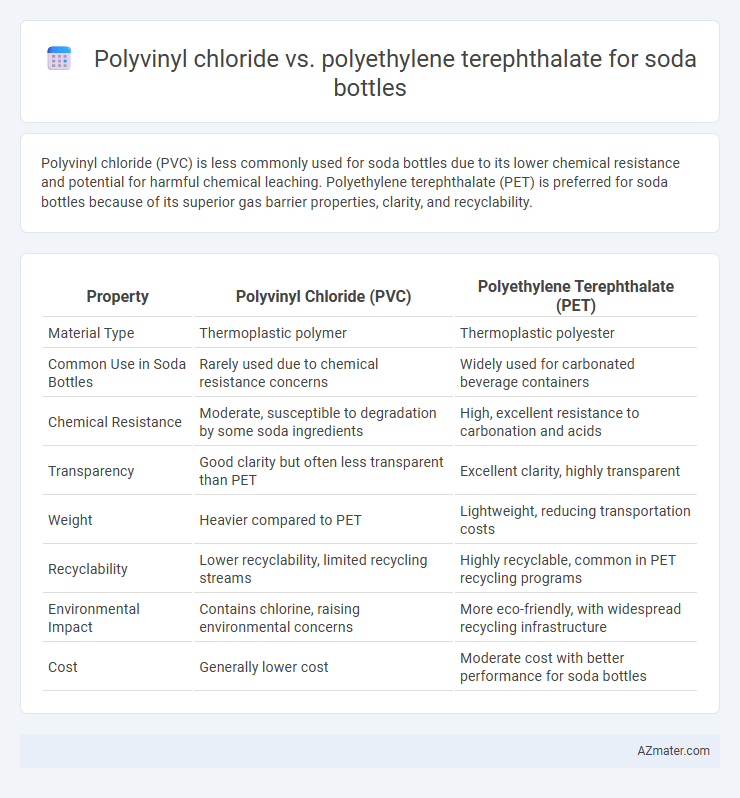Polyvinyl chloride (PVC) is less commonly used for soda bottles due to its lower chemical resistance and potential for harmful chemical leaching. Polyethylene terephthalate (PET) is preferred for soda bottles because of its superior gas barrier properties, clarity, and recyclability.
Table of Comparison
| Property | Polyvinyl Chloride (PVC) | Polyethylene Terephthalate (PET) |
|---|---|---|
| Material Type | Thermoplastic polymer | Thermoplastic polyester |
| Common Use in Soda Bottles | Rarely used due to chemical resistance concerns | Widely used for carbonated beverage containers |
| Chemical Resistance | Moderate, susceptible to degradation by some soda ingredients | High, excellent resistance to carbonation and acids |
| Transparency | Good clarity but often less transparent than PET | Excellent clarity, highly transparent |
| Weight | Heavier compared to PET | Lightweight, reducing transportation costs |
| Recyclability | Lower recyclability, limited recycling streams | Highly recyclable, common in PET recycling programs |
| Environmental Impact | Contains chlorine, raising environmental concerns | More eco-friendly, with widespread recycling infrastructure |
| Cost | Generally lower cost | Moderate cost with better performance for soda bottles |
Introduction to Soda Bottle Materials
Polyvinyl chloride (PVC) and Polyethylene terephthalate (PET) are common materials used in soda bottle manufacturing, each offering distinct properties. PET is widely preferred due to its superior clarity, higher impact resistance, and better gas barrier qualities, which help maintain carbonation and flavor. PVC, while cheaper, tends to have lower transparency and less effective barrier performance, making it less suitable for preserving soda freshness over time.
Overview of Polyvinyl Chloride (PVC)
Polyvinyl Chloride (PVC) is a durable, rigid plastic widely used in packaging but less common for soda bottles due to its lower impact resistance and potential chemical leaching compared to Polyethylene Terephthalate (PET). PVC exhibits excellent chemical resistance and can withstand various environmental conditions, making it suitable for non-food packaging applications. However, its lack of clarity and recyclability challenges limit its use in soda bottles, where PET's superior transparency and safety profiles are preferred.
Overview of Polyethylene Terephthalate (PET)
Polyethylene terephthalate (PET) is a thermoplastic polymer widely used for soda bottles due to its excellent strength, transparency, and gas barrier properties, ensuring carbonation retention and beverage freshness. PET's lightweight nature and recyclability make it an environmentally favored choice compared to polyvinyl chloride (PVC), which poses challenges like potential chemical leaching and higher environmental impact. The material's resistance to impact and ability to be molded into various shapes contribute to its dominance in the beverage packaging industry.
Chemical Properties: PVC vs PET
Polyvinyl chloride (PVC) exhibits strong chemical resistance to acids, bases, and salts but can release harmful hydrochloric acid when heated, limiting its safety for soda bottle applications. Polyethylene terephthalate (PET) offers excellent chemical stability, is resistant to carbonation pressure, and maintains flavor integrity without leaching chemicals. PET's superior gas barrier properties and inert chemical profile make it the preferred choice over PVC for carbonated beverage containers.
Mechanical Strength and Durability Comparison
Polyvinyl chloride (PVC) exhibits lower mechanical strength and flexibility compared to polyethylene terephthalate (PET), making PET the preferred material for soda bottles due to its superior tensile strength and impact resistance. PET offers enhanced durability under environmental stress, including resistance to pressure, temperature fluctuations, and chemical exposure, which ensures longer shelf life and product safety. PVC's susceptibility to cracking and deformation under stress limits its use, whereas PET's robust structural integrity supports efficient carbonation retention and transportation resilience.
Barrier Properties: Carbonation and Moisture Retention
Polyvinyl chloride (PVC) offers moderate carbonation retention but limited moisture barrier properties, leading to potential gas migration and loss of soda fizz over time. Polyethylene terephthalate (PET) exhibits superior carbonation retention and excellent moisture barrier capabilities, making it the preferred choice for soda bottles to maintain freshness and prevent carbonation loss. PET's high barrier efficiency significantly prolongs shelf life by minimizing both CO2 escape and moisture ingress compared to PVC.
Safety and Health Considerations
Polyvinyl chloride (PVC) soda bottles pose higher safety concerns due to potential release of harmful additives like phthalates and vinyl chloride monomers, which can leach into beverages and pose health risks. Polyethylene terephthalate (PET) is widely preferred in beverage packaging because it is BPA-free, exhibits minimal chemical leaching, and provides a safer alternative for direct food and drink contact. Regulatory agencies such as the FDA and EFSA recognize PET as safe for soda bottles, while PVC is less commonly approved due to its chemical instability and associated toxicological issues.
Environmental Impact and Recyclability
Polyvinyl chloride (PVC) produces harmful dioxins during incineration, posing significant environmental risks, whereas polyethylene terephthalate (PET) offers a safer profile with less toxic emissions. PET bottles boast higher recyclability rates globally, commonly processed in closed-loop systems to create new beverage containers, unlike PVC, which is less frequently recycled due to chemical complexity and contamination concerns. The environmental impact of PET is comparatively lower, benefiting from widespread recycling infrastructure that reduces landfill waste and conserves resources.
Cost Analysis: PVC vs PET in Manufacturing
Polyethylene terephthalate (PET) typically offers a lower overall manufacturing cost for soda bottles compared to polyvinyl chloride (PVC), largely due to PET's more efficient production process and higher material yield rates. PVC incurs increased expenses from additional processing steps and environmental regulations related to its chlorine content, which can raise compliance and disposal costs. PET's recyclability and lighter weight contribute to reduced transportation and lifecycle costs, reinforcing its economic advantage in soda bottle manufacturing.
Industry Preferences and Future Trends
Polyvinyl chloride (PVC) is less favored in the soda bottle industry due to its lower chemical resistance and potential health concerns, whereas polyethylene terephthalate (PET) dominates with its superior clarity, strength, and recyclability. Industry trends show a significant shift towards PET driven by its lightweight properties and enhanced barrier performance, which improve shelf life and consumer appeal. Future developments emphasize bio-based PET alternatives and advanced recycling technologies to meet sustainability goals and regulatory pressures.

Infographic: Polyvinyl chloride vs Polyethylene terephthalate for Soda bottle
 azmater.com
azmater.com